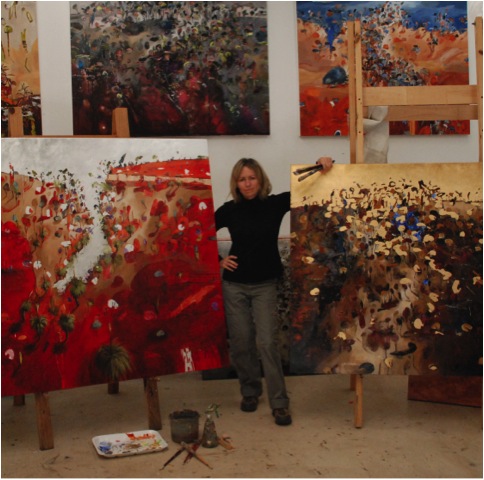Anita West Painter - Brisbane, Australia
Your current work is very different from your landscapes. Can you discuss your work ‘Banksia?’
This is the first painting in a new direction for me. Instead of using aerial views with horizon lines showing vast distances, I wanted to create works that explore the idea of being intimate with the bush, to feel as though the bush is very close. So the composition and space describes the experience of walking through the bush. Also I wanted to change focus from using the horizon line to making the distinction between sky and earth disappear. I am also using the random flow of transparent acrylic paint in the first layer to inform the composition. So I never quite know what is going to happen and I find that really exciting.
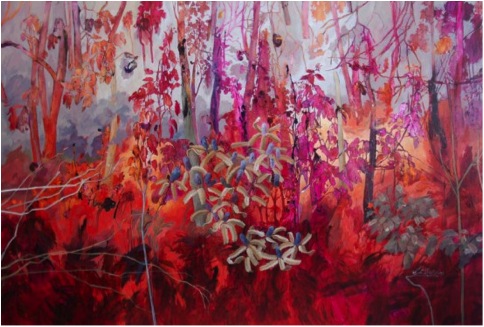
‘Banksia’
How did you develop this new work?
I think that after 10 years of living in a house that looks out across a strong foreground, middle ground and background that is defined by gum trees, native bush, flowers and a creek I have finally figured out a technique that has endless possibilities and more importantly it feels authentic and personal.
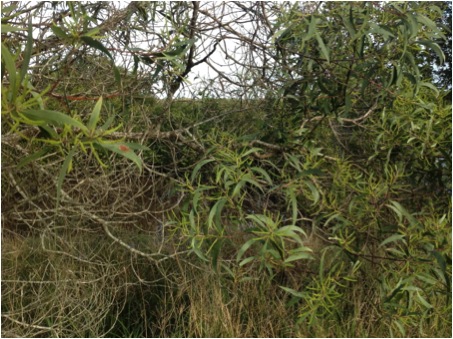
Inspiration for ‘Banksia’
Can you discuss the importance of colour in this work
I just visualised this colour in my mind before I began, possibly because I didn’t want to end up with a painting that looked similar to any of the resource photos I used. When I choose a colour that is purely emotive, it keeps the feeling quite distant from the reality of the bush and then all of those romantic and emotional connections can be readily tapped into without having to resort to representation.
Your beach-scapes are full of the Australian beach imagery, expand on this?
I have always enjoyed paintings that tell a story. I live such an ordinary life as a mother and wife living in the suburbs and I suppose the only advantage I have as an artist is that my experiences of family holidays at the beach with children are much like that of most other families, so there is an immediate connection with the love we have of the beach and our celebration of living in such a beautiful country.
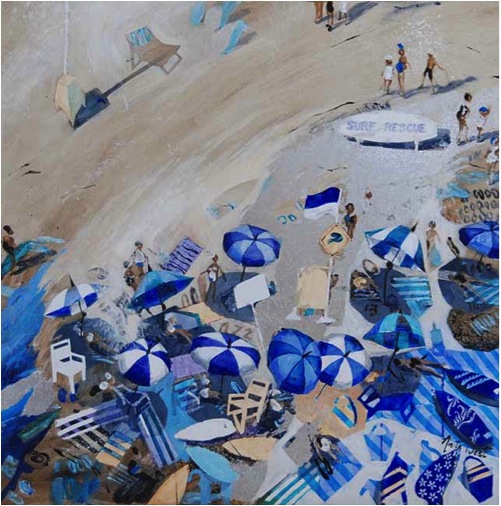
‘Blue Chairs’
Discuss the composition in relationship to people, beach and sea?
I have all sorts of fun changing the compositions and perspectives of the works. They are often quite jumbled up and many of the rules of composition are broken, proportions are deliberately changed and the horizon line and viewers perspective are often not formally accurate. I use odd angles and some completely nonsensical imagery, but I think that it just adds to the fun and life of the beach. I don’t have a really tight formula, so I get to play with composition all the time – which is always the most important principle behind my paintings. The more beach paintings I create, the more ideas I come up with until summer is over and I start thinking about bush landscapes.

‘Walking the Beach’
Discuss how you use perspective so strongly in all your work?
Sometimes I use the typical western perspective with horizon lines, vanishing points and colour intensity varying into the distance. Other times I use a more eastern idea of perspective or ‘stacked space’ where imagery at the top of the painting is read as being in the distance and imagery at the bottom (although the same size) is read as being in the foreground. I love Egyptian art where motifs are flattened, objects are stylized and symbols become hieroglyphic. I am inspired by so much, I want to put it all in! It is difficult to work out what to leave out, and that is why so many of the beach paintings are very busy.
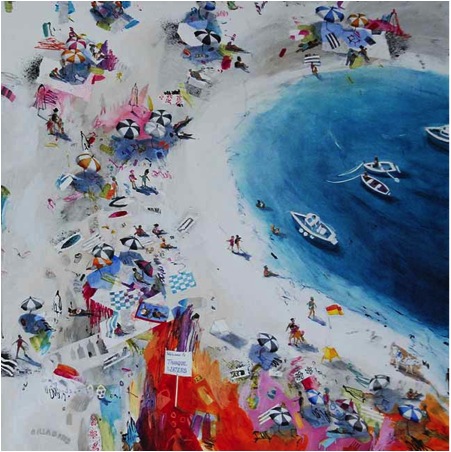
‘Tranquil Bay 2’
You have lived in both Australia and America (East Coast), how has this tuned your use of colour in your art work?
Colours in Australian landscape are so different from anywhere in the world. There is so much grey-green in the Eucalypt bushland and yet the hills in the distance are such a vivid blue because of the eucalypt haze and the sky is so clear. I am always looking up at the sky especially the cloud formations which are just spectacular in Australia. I don’t notice the skies so much overseas because the light is softer and often more quiet.

‘Bush Quarry’
You are very comfortable with colour. Can you discuss this in relation to…
‘Wild Berry Beach’
Sometimes, to keep myself challenged, I choose a colour scheme that does not readily find truth in a subject. To use an analogous palette with predominantly pinks requires considerable forethought. The best approach I have found when working with a limited colour palette is to choose a style of painting (mostly abstracted patterns stencilling in these) that suits the mood of the colour which in turn complements the subject of the beach. Using a grey scale also offsets the pink and primed linen is untouched in some areas. There has to be strong tonal variations in the colour to enhance the design. I have used mostly stylized compositions and flattened spaces in this series of 16 small paintings.

‘Wild Berry Beach’
‘Turquoise Bay 4’
I am comfortable using colour, but I mostly limit my colour palette to predominantly one or two colours with variations in tone and texture. I don’t like being confused by too much colour as it is such a powerful emotive tool. My beach scenes are mostly blues and neutral sand colours with a set of minor colour combinations that I use to play with decoration and pattern. In this series of four paintings I have used a palette of bright spectrum colours in the patterned objects to create a vibrant atmosphere. I use colour to bring a specific mood into the work, tones to bring out form and space, and then texture to enhance patterns and rhythms. But I want the paintings to be mostly about the story or narrative.
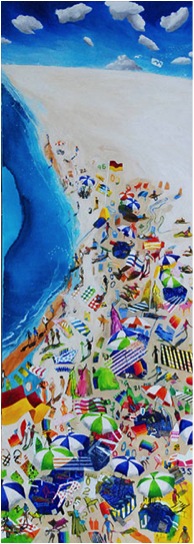
‘Turquoise Bay 4’
Your work is becoming more abstract, explain?
I have never considered myself to be an abstractionist. I like having an anchor of reality somewhere in the work. Some years I gravitate more towards the abstract, but then I swing back into representational work to become grounded again. I like having the flexibility to move in between different stylistic approaches, so that I don’t pigeon hole myself and limit those choices. So I firstly decide how I want a painting to feel – what mood it will have – and then I use composition to give structure, colour and tone to create the mood, then I use subject matter, form and shape to give the narrative. If abstracting areas helps to create this feel then that is what I use, and it is a great way to discover new ideas.

‘Desert Acacia’
How have other Australian Artists influenced your work particularly your landscapes?
Studying how other artists view the landscape gives me leverage on what has been done before and the infinite ways of expressing it. I am very conscious of where many of my marks, perspectives and colours are gathered and am always happy to acknowledge those influences. On a more general level, I am most inspired by artists who find their own voice and reach out to reveal something surprising and mysterious. I have a long list of Australian artists who have inspired me but I love the Aboriginal Art Movement in particular, maybe because as a non-Aboriginal artist I know that I can never access those stories. I also tend to like artists whose work is completely different from my own but I can see that they are attempting to navigate similar ideas about the land.

‘Salt Lake and the Motorbike Track’
Your images of the bush (landscape) are an impact of colour – Australian colour. Can you discuss this?
I spend a lot of time walking in the bush and I have grown to love the subtle earthy colours of eucalypt scrub, the bleached colours from the midday sun, the harmonious soft colours at sunrise and the dramatic, mysterious colours of twilight. I am trying to paint how I feel when I am immersed in the bush. It is the place where I feel the most connected with life, with nature, and it nourishes my soul. And I know that for most of us, being in the landscape whether its camping, going for drives into the mountains, or out in a boat, we feel something that is difficult to express or describe. How do you paint that? I don’t know and I am not sure if I will ever be able to, but I keep trying.

Hillside with a Rockpool’
Can you explain about the commission you have recently had for Soul Apartment Tower on the Gold Coast, Australia?
This commission was inspired by Blue Lake on North Stradbroke Island, a place that we visit on family holidays. Blue Lake is a sacred Aboriginal site but is open to the public to enjoy. To get there you have to walk through some beautiful banksia and grevillea shrubs with lots of scribbly bark eucalypt trees and white sand. The lake is a vivid blue because it is so deep and it is part of the water source for the mainland.
Size – what is the average size of your work?
This varies so much, I used to paint and embroider miniature pieces in earlier years and still enjoy making intimate works, a lot of my larger pieces have intimate vinaigrettes of stories that make up a whole. The largest paintings are around 2 metres in length and smallest around 40cm. So the average would have variations of around 150cm. I love painting big as it is such a commitment to the idea and has such a powerful effect if I can get it right.
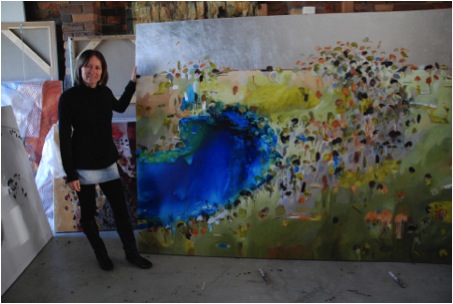
Medium – what various mediums do you use?
Like most artists and teachers, I have used just about everything possible to explore all the elements of art. These days I paint mostly in acrylics and permanent inks. I use dry media like charcoal or pencil for drawing then build up layers with glazes and use opaques more sparingly as final layers. Sometimes I add gold or silver dutch metallic papers to represent the sacred or preciousness of the landscape. I also still enjoy painting in oils and I always add a small group of these in a show.
Your work is a true travel log. Can you discuss the importance of travel to your work?
Travelling invites the unexpected. I like that because it gives pause to our lives and can change the way we think and behave. It helps me to become more conscious of my place in the world and reflect on the bigger picture. My travelling has been regular and important for my work, especially travel within Australia because it confirms the reason why I paint landscape. It helps me to feel excited and unafraid of losing control on the canvas and inviting serendipitous elements and letting big ideas flow. I would like to travel more as the children get older, and I like the idea of looking into doing some residencies.
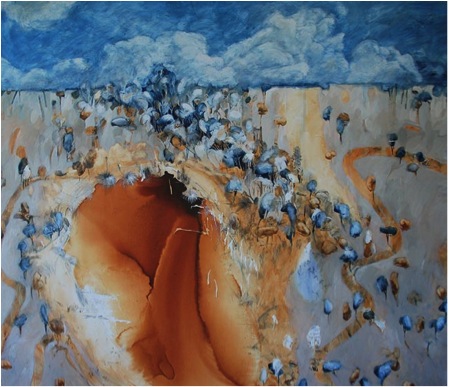
‘Brown Lake’
While travelling, how do you record?
I use a small visual diary that I write and draw notes in. The camera is a godsend, but mostly I just use my memory as a filter. I have never liked the idea of seeing the world behind a camera so I try to soak up those momentary experiences when I am there. Sometimes I don’t think about recording anything when I am travelling, I give my creative brain the time to empty itself of ideas so it has a chance to soak up some new ones.
Everyone loves to see and hear about an artist studio. Would you share yours?
Everyone loves to see and hear about an artist studio would you share yours?
In March this year I decided I needed to find a place to work with other artists, so I have rented a small studio space in a renovated warehouse that is run by a talented group of academic artists who paint and teach classical drawing. There is a wonderful sense of camaraderie amongst the artists, teachers and students and I love the energy of the place. However, It is a 40 minute drive from my home so I only work there 3 days a week. This is where my new direction began, and I wonder if it is because I have removed myself from the immediate bush surrounds of home into an industrial setting.
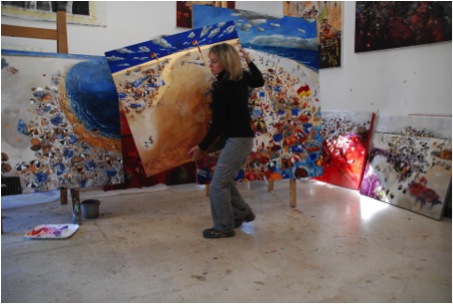
Working from a home studio for over 20 years has its ups and downs. I have certainly learnt techniques needed to avoid prolonged procrastination! Also I have become strong enough not to succumb to the continual distraction of my two gorgeous children and family duties. But the greatest advantage of which I am very thankful for, (and I am only now becoming more aware of) is the opportunity to truly focus on finding direction, meaning and sustenance in my art without the direct influence and crutch of other artists, tutors or academic spheres. Being alone in a studio for a sustained amount of time has given me considerable scope to produce an immense body of work that keeps developing and growing.
And the wonderful thing about renting a studio with other artists is that I don’t feel so alone! I love being connected with other artists on a daily basis, it is a wonderful antidote to the isolation of being at home.
How influential are your galleries to the output of your work?
An interesting question and one which I contemplate often. When I am in my studio I consciously try to put aside the business of art and gallery influences and commitments. I take one day at a time, one step at a time, and think about only what it is that I am trying to express on the canvas. Nothing else matters then. Going down the road of making art designed to sell or designed to somehow predict the chances of selling is a tricky business and one that is fraught with danger and disappointment. As my gallerist Trevor Harvey says to me; “ You are the driver, take people along for the ride, you could be surprised”.
You have had many sales? And has there been one that gave you that boost you needed?
Probably the first corporate sale through Robertsons Interior Design about 15 years ago propelled me to paint more work which ended up turning into a 7 year contract to produce 25-30 feature paintings each year for their showroom. I had to work very hard late into the night because that is the only time I could find. My children were still in nappies!
The best thing about selling work is, knowing that in a very direct way I have made a connection with another person and that they will get joy out of something that I have created, just as I do when I buy artwork from other artists. Making a living from painting sales is very validating, not because of the recognition but simply because I am sharing my love of Australia and how I perceive my place within it. I must also mention how important it has been for me to find and be represented by TVH gallery who have been very supportive and work hard to represent their stable of artists. It is a vital component in the link between artist and client.
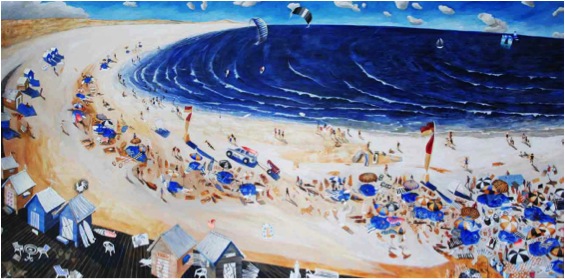
‘Beach Huts on the Broadwalk’
Discuss the increasing development of Australian awareness to the environment and how this is affecting your work?
I have been doing a lot of reading about human consciousness and our behaviour towards each other and to our planet. I am becoming more aware of how so many other artists are making art about this. Not just visual art, but through music, dance, theatre, movies, books, food, and all art forms. I think that good art is about giving us pause to explore our own consciousness and to increase our awareness of how we can live a life of love, compassion and respect.

Contact details:
a_west@bigpond.net.au
www.anitawest.net
Anita West, Brisbane, Australia
Interview by Deborah Blakeley, December 2013
Think a colleague or friend could benefit from this interview?
Knowledge is one of the biggest assets in any business. So why not forward this on to your friends and colleagues so they too can start taking advantage of the insightful information the artist has given?
Other artists you may be interested in:


